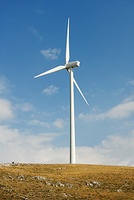
Image: http://www.flickr.com/photos/mauro_orlando/3846878544
Speaker: Brigitte Knopf
Description
This activity analyzes pathways towards a low carbon economy that are in line with ambitious climate policy objectives such as the 2°C objective. The focus is on the technological feasibility and economic costs of such low stabilization pathways. We mainly conduct analyses on the global level and deduce mitigation strategies for the major emitting regions. We also consider some focus regions in more detail, e.g. the transformation of the energy system in Germany.
Options to reduce carbon dioxide emissions include the use of less energy per unit production or consumption, the substitution of fossil fuels with low carbon alternatives, and the sequestration of carbon dioxide from fossil energy conversion processes (CCS). We employ a coupled energy-economy-climate model, REMIND, to derive scenarios for the deployment of these mitigation options and the associated costs of reaching low stabilization targets. This is augmented by a broader assessment of sustainability criteria and an analysis of ancillary costs, risks and benefits of the transformation pathways. Examples include the large-scale deployment of bio-energy technologies, or the use of CCS. The scenario analysis can take technical and social limits (e.g. concerning acceptability) explicitly into account. Of special interest is the comparison of scenarios characterized by fragmented climate policy regimes, limited technology availability and/or market imperfections with benchmark scenarios exhibiting full mitigation flexibility.
To analyze low stabilization targets in a systematic and policy relevant manner, all sources and abatement options for CO2 and non-CO2 emissions should be considered. As Greenhouse gas emissions from land-use, land-use change and forestry (LULUCF) account for about one third of the total global greenhouse gas emissions, the REMIND model is coupled to the global land and water use model MAgPIE of RD1 to account for costs, risks and benefits of land-use related mitigation options, e.g. avoided deforestation or intensive use of bioenergy.
The effect of uncertainty about key socio-economic and climate characteristics is investigated in reduced form models of the global coupled energy-economy-climate system. Key questions are how climate targets in an uncertain world can be conceptualized, how the consideration of uncertainty changes the mitigation strategy, and which role the anticipation of future learning can play.
Methods
The analysis is mainly based on scenario analysis with different versions of the energy-economy-climate model REMIND, available at different regional disaggregation levels: a version featuring 11 world regions, a global version, and a German version. For land-use related questions, the model is coupled to the MAgPIE model. Model comparisons with other modeling groups are an important characteristic of the Mitigation Scenarios project as they provide a useful way for figuring out differences between models and identifying robust conclusions about feasibility and costs of stabilization pathways.
Products
- Global scenarios of transformations to a low carbon economy that reach ambitious climate targets under various assumptions about technology availability and policy configuration
- Integrated Assessment Model comparison exercises
- Transformation pathways towards a low carbon economy for Germany.





